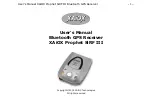
19
Note: If you need to zoom out briefly to locate your position on the map, use the
Overview mode instead of zooming out and back in. The Overview mode is a 2D
North-up view that can be started by tapping the compass button on the right (Page
33).
Note: XROAD has a special Smart Zoom function for navigation that automatically
rotates, scales and tilts the map in 3D map mode to always give you the optimal view
in your current situation. When approaching a turn, it will zoom in and raise the view
angle to let you easily recognize your maneuver at the next junction. If the next turn
is at a distance, it will zoom out and lower the view angle to flat in order to let you
see the road in front of you.
4.3.3 Daylight and night color schemes
The different color schemes let you adjust XROAD to the brightness of the
environment. Use the daylight and night color schemes accordingly. Daylight colors
are similar to paper roadmaps, while the night color schemes use dark tints for large
objects to keep the average brightness of the screen low, with carefully selected
colors to still keep you informed about all the necessary information on the screen.
You can change between day and night views manually in the Quick Menu (Page
43) or let XROAD do it automatically (Page 60) for you.
Note: The automatic day/night mode is based upon the current date and GPS
position by which XROAD calculates the exact sunrise and sunset times on the
particular day at the particular location. Using that information XROAD can
automatically switch between the color schemes a few minutes before sunrise, when
the sky has already turned bright, and a few minutes after sunset before it gets dark.
Tip: There are several daytime and night color schemes included with XROAD. To
select the one that suits your needs the best, make your selection in Settings (Page
64).
Tip: To further enhance the effect of the night color scheme, you can instruct
XROAD to decrease the display backlight when the night colors are used. Set the
desired backlight levels for both daylight and night modes. Page 71.
















































